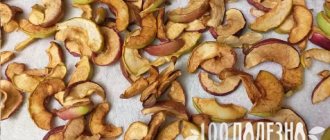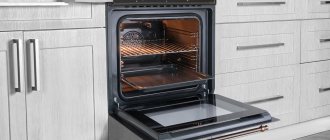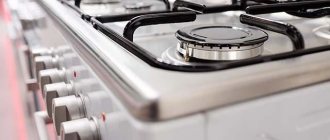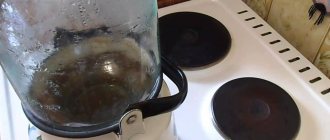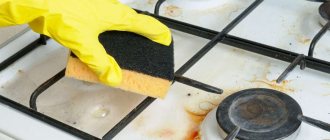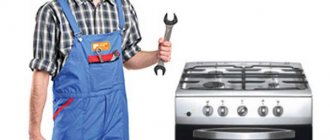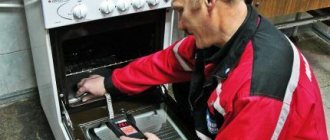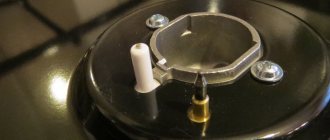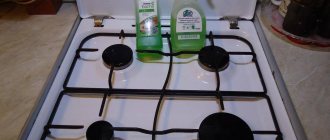Despite the abundance of modern materials for making tableware, ceramics remain unrivaled. No, no one is suggesting replacing practical and easy-to-clean stainless steel sets with heavy ceramic products, but it is recommended to have at least one such saucepan in the kitchen.
And it’s not just a fashion trend when natural materials are welcomed. Everything is much simpler: dishes in ceramic dishes taste excellent, so if you plan to surprise your family with culinary masterpieces, it’s time to buy such utensils.
What is ceramic tableware
There is a misconception that dishes with a ceramic coating are an analogue of porcelain dishes with additional technical functions. This is wrong. A ceramic coating is in no way related to the same ceramics made from clay. In the manufacture of this material, gel-sol technology is used, which requires special conditions and equipment.
Ceramic pans have been popular among consumers for many years.
The coating combines tiny particles of sand or other minerals in different ratios, which allows you to create other types of ceramic coatings that have their own unique characteristics.
What you need to know about ceramics
In everyday life, we often call all pots and pans made of clay ceramic. This is not entirely accurate, although porcelain and earthenware products are based on the same raw materials. There are few differences:
- In the production of ceramic products, in addition to clay (base), various mineral components are added to the material. Thanks to this, the degree of absorption, porosity, and color of the mass change, and the products themselves acquire new properties;
- According to the technology, clay utensils undergo one firing. The ceramic pan is additionally coated with glaze and fired again, but at a lower temperature.
Both glazed and regular utensils are used in the kitchen. But traditional clay products have quite a lot of restrictions on operating conditions. Modern ceramic pans are more practical and convenient, and some models are even suitable for induction cooking.
Advantages and disadvantages of ceramic pans
Ceramic kitchenware has become very popular in recent years. If we compare it with Teflon analogues, ceramic products are much more convenient in cooking and are absolutely safe.
The following advantages of these pans can be noted:
- has high strength;
- will last up to 10 years;
- the ability to prepare food using metal utensils;
- can withstand very high temperatures (450°C);
- food on such a coating will not be able to burn;
- easy dishwashing;
- heat is distributed evenly;
- food is prepared faster;
- preservation of beneficial properties in food;
- There are different shapes and shades of products.
Environmentally friendly and natural materials that do not emit harmful substances during cooking. There is also no plaque or scale on the walls of the dishes.
How to wash and clean?
The ceramic-based coating easily withstands the aggressive effects of chemicals and high temperatures, so such products can be cleaned in the dishwasher. However, most housewives prefer to wash such products by hand, using standard cleaning compounds for kitchen utensils.
Experts recommend giving preference to gel detergents when cleaning ceramic containers. For example, Cif gel is an effective cleaning product. It must be used according to the instructions.
Types of ceramic pans
Products are divided into the following materials:
- aluminum;
- cast iron;
- steel;
- glass;
- ceramics;
- silicone
The ceramic layer for cookware consists of a metal alloy, therefore it is highly durable and wear-resistant.
Each material has its own characteristics. Some are suitable for any stove, others are used only in specific ovens and hobs.
What to look for when choosing
Even without experience using the products, it is not difficult to find a good saucepan if you know a few important nuances. Remember that high-quality tableware is never cheap; when you need to save money, it’s better not to even look for ceramics. And in order not to make a mistake when choosing, remember simple tips:
Give preference to well-known companies that have been on the market for a long time. To find out whether there are certificates of conformity for products, be sure to check the warranty period, it should be at least a year.
What materials are ceramic coated pots made from?
Pans with this coating have a metal base, which is coated with a mineral composition and special enamel. For this coating, natural materials are used, which are part of glass and ceramics. But polymeric substances can also be used in the manufacture of coatings, so when purchasing, you need to clarify what exactly the manufacturer means by “ceramic coating.”
The protective ceramic coating is applied in several layers.
Cast aluminum
For the production of the body base, food-grade cast aluminum is most often used. It is thanks to him that the products have:
- high thermal conductivity;
- practicality;
- light weight.
Cast products are quite thick-walled and compacted.
Extruded aluminum
For the manufacture of these pans, stamped aluminum is also used. The price of these pans is much lower than those made of cast aluminum, and the service life is also shorter. This is due to the fact that thin aluminum is used, which is prone to deformation, chipping and cracking. Do not store food in these pans.
This type of cookware is perfect for sautéing and frying foods.
Steel
This material is used only when the dishes have a three-layer base, the middle layer being aluminum. This material conducts heat poorly, so steel is used only in combination with this malleable metal.
Steel is one of the most durable materials used in the production of cookware.
Disadvantages of ceramic pots: heavy weight and high price. The three-layer base ensures low gas and electrical energy consumption due to the fact that the ceramic heats up quickly.
Cast iron
Durable cast iron pans are made for frying and baking, as well as for dishes that require long cooking - stewing, simmering, baking. These products are allowed to be placed in the oven if a heat-resistant lid and handles are missing.
The material has a natural non-stick property, but its appearance occurs after the pores are clogged with fat.
Despite the massiveness of cast iron products, they can last for decades.
One of the main disadvantages is its heavy weight, and it is prohibited to store cooked food for a long time in an uncoated pan.
Review of the best models
The ranking of ceramic pans includes products from domestic and foreign companies: mainly premium-class cookware, as well as the middle price segment.
Frybest
The brand is represented by the South Korean concern NEOFLAM. The main lines are dishes with a special coating based on steel and aluminum, but there are also completely ceramic series.
The Mystic collection is designed for dishes that require long simmering. There is glaze on top of the ceramics, as well as an additional antibacterial layer. The original design attracts attention, while the food inside does not burn or stick (see video).
The Mystic series ceramic saucepan with a lid is suitable for gas, electric and glass ceramic stoves. The exception is induction. Dishwasher safe. The cost of the 1.4 liter model is 4000-4200 rubles.
Hans & Gretchen
The basis of the Hans & Gretchen company concept is the production of kitchen utensils from natural materials. Production is located in South Korea, products are sold in dozens of European countries.
Pans of the Baum Blue, Baum Green, Baum Yellow, Baum Orange series are made of heat-resistant ceramics. The walls of the case and the bottom are thick, ensuring uniform heating and long-term heat retention. The body of the cookware is black, the lids are colored, with a relief image of leaves. There is a hole for releasing steam.
Suitable for all types of stoves (except induction), ovens, microwaves. Used for stewing and baking. Cost – 2000-2200 rubles.
Emile Henry
A famous French brand whose products belong to the elite category of tableware. Production is located in Burgundy. Only natural materials are used. Emile Henry is a family business. Currently, the company is led by representatives of the sixth generation of the Henri dynasty.
The basis of the products is raw clay from nearby deposits and special oxides to enhance the color of the glaze. Innovative Flame ceramics protect against damage, foreign odors, and preserve the natural taste of products.
You can cook, stew, bake, or cool dishes in pans. The coating is a high-quality glaze, so the dishes are suitable not only for cooking, but also for serving the table.
In assortment:
- multi-pots (volume 2 l) for cooking pasta, legumes, cereals, rice, meat;
- oval and round models (volumes 5.3 and 6 l);
- Delight series (induction).
The cost of a 2 liter pan is 7800-8000, a 5.3 liter pan is 15000-15500 rubles.
Ceraflame
There are many positive reviews for cookware from the Brazilian brand Ceraflame. In addition to Turks, mugs, and ceramic glasses, the company produces a line of saucepans.
The products are resistant to thermal shock and are suitable for cooking, heating, and defrosting. Suitable for all types of stoves (except induction), for cooking over an open flame (fireproof clay is used). Withstands high temperatures and is dishwasher safe.
The cost of a 3.5 liter pan (Ceraflame Chef series) is 6000-7000 rubles.
Appolia
The dishes of this brand are easy to recognize by their original shapes and bright colors. “Curved” saucepans from the Terre & Flame series are made of high-quality clay and are suitable for any hob (except induction). The manufacturer even allows cooking over an open fire.
Temperature range: -20 ºC to +250 ºC. After washing, it is recommended to dry the dishes thoroughly and store them with the lid ajar.
Cost: 91,000-10,000 rubles.
Borisov ceramics
This is a domestic manufacturer (Belgorod). Red clay is used for the base of the products, and varieties of materials are used for decoration, giving different shades when fired.
The assortment includes about 300 different products, including saucepans, baking pots, and tureens. It’s convenient that dishes from many series are suitable for table setting in addition to cooking.
Cost: 0.65 liter pot - 200 rubles, tureen with relief decoration (for stewing, baking, serving ready-made dishes) - 3000 rubles.
Dimensions
Pots are divided by size according to:
- diameter of the top surface and bottom;
- volume;
- height.
The smallest product size, with a volume of 1 to 3 liters, is ideal for preparing small portions. Convenient for boiling milk, cooking porridge, mashed potatoes or soups.
The walls and bottom of the products are compacted and can withstand any serious damage.
Pots with a capacity of 3 to 5 liters are suitable for preparing small portions of soups or borscht, for cooking vegetables, meat, dumplings.
Large-sized pots, from 5 liters, are purchased to cook compotes, pickle cabbage, and prepare food for the whole family.
Main Differences
A ceramic pan for a gas stove or oven can have different sizes and shapes. It is made from various materials, and strength and durability largely depend on this. You need to understand all the nuances in advance in order to understand which ones are best to use and which ones should be abandoned.
What are they made from?
Any of the options is a metal base on which ceramics are applied, on top of which is a coating of special enamel that makes the surface attractive and closes all pores. There are only 4 types, each of them has advantages and disadvantages:
Information about the material must be indicated on the label. If it's not there, it will most likely be cheap extruded aluminum, which can be easily identified by its light weight. Steel options are an order of magnitude heavier, and the heaviest are cast iron.
Shapes and sizes
Take these factors into account in order to choose what is suitable for preparing certain dishes. As for the sizes, everything is simple - there are options for 2-3 liters for a small family, and there are varieties with a capacity of 3 to 7 liters. According to the form, the following types can be distinguished:
If earthenware cannot be used on a gas stove, then ceramics with similar characteristics can be used, which allows you to cook more different dishes. The main thing is to choose the shape and size; options that are too large are just as undesirable as options that are too small.
Type of handles and lids
The handles must be firmly attached to the body, because Poor fastening can cause burns. To eliminate the risk of burns, you need to select pans with rubber handles.
Plastic ones are not so practical; they are prone to melting.
If you choose metal handles, they are made of metal. Their edges do not heat up. They are also easier to clean and can be used to cook in the oven.
Ceramics does not tolerate sudden temperature changes.
When choosing a lid, pay attention to the material; it should be the same as the pan, or made of heat-resistant glass. The glass lid allows you to monitor cooking and boiling.
The lid should fit tightly, have holes to allow steam to escape, have a comfortable and secure handle, and be tall.
Ceramic cookware for a gas stove is made from environmentally friendly raw materials.
Recommendations for selection
To buy a ceramic pan that meets your needs, clearly describe your goals and compare the characteristics of the cookware in question with your goals.
What to pay attention to:
- If the pan is needed only for the oven, a bottom thickness of 5 mm is sufficient. For cooking on the stove, it is desirable that the bottom is at least 7 mm. An induction cooker requires a metal bottom. You can also use an adapter adapter.
- Review the manufacturer's information. Please note that the cookware may only be used as specified in the specifications.
- Inspect the product. The bottom surface should be evenly covered with glaze inside and out . There may be no glaze only on the outside of the bottom.
- Check how the canvas fits the lid. If the handle on the lid is removable, evaluate the fastening.
- Hold the handles to see how comfortable and reliable they are. Otherwise, the pan may jump out of your hands.
Give preference to products that have certificates and well-known manufacturers. Handicraft dishes are more suitable for souvenirs.
Depending on the type of slab
The first question people ask themselves when choosing these products is: is it possible to cook on a ceramic stove in ceramic dishes? The answer is yes, you can, but be careful. Such dishes are chosen based on the stove. Not every pan can be used on a gas stove, or you can heat food in a microwave or electric oven. But these pans are great for cooking delicious dishes in the oven.
When cooking food, no hazardous substances are released that are harmful to human health.
Gas stove
Some ceramic products are prohibited from being used for cooking on gas stoves, due to the possible lack of uneven heating, as a result of which the pan may burst.
To use this cookware on gas burners, you should buy a flame divider; thanks to it, the cookware will heat up evenly, eliminating the risk of cracking.
Since the protective coating is applied in several layers, the risk of scratches is significantly reduced.
Despite the fact that it is not recommended to use ceramics with an open fire, current manufacturers have produced pans with a thick bottom, reinforced with additives, they can be used on gas stoves.
Electric stove
Manufacturers have made special pans for electric stoves and glass-ceramic burners. They have a flat bottom, which ensures maximum adherence to the hob.
In such kitchen utensils you can cook with a minimum amount of vegetable oil.
But in practice it turned out that using ceramic pans on such stoves leads to high energy consumption. Cooking occurs more slowly, dishes lose their juiciness and taste. There is a risk of overheating the edges of the product and breaking the electric stove.
Rules of care
After purchasing new ceramic dishes, you need to wash them well in slightly warmed soapy water, then dry them and wipe them thoroughly with a soft towel.
The rules of operation and maintenance are elementary:
- To clean the pan using a dishwasher, set the minimum temperature so that the oxide film remains intact.
- To improve non-stick properties, before cooking, grease the inner surface with a thin layer of vegetable oil. Heat on fire for one minute.
- Do not use metal spatulas to stir food in ceramic dishes. They can cause damage to the coating. Silicone or wooden devices are considered the best option.
- The pan must be protected from sudden changes in temperature. Before putting food from the refrigerator into it, you need to let it sit for about 15 minutes at room temperature.
- Products are washed only when they are completely cool.
Professionals advise not to use a dishwasher to wash ceramics at all; it is better to do the procedure manually. Each ceramic kitchen utensil must come with instructions that tell you in detail how to properly care for it. If you follow these instructions, the cookware can be used for a long time.
Select the minimum water temperature in the dishwasher
Lubricate the bottom with oil
Use a special spatula
Avoid temperature changes
You should wash it only after the pan has cooled down.
Purpose and form
Due to its heat resistance, the cookware can be placed in the oven without first greasing the inner surface with oil. Thanks to this, you can cook various dishes in it that will be of high quality. The volume of products is often small, usually three liters, this is explained by the large weight of the product.
Universal pan
Ceramic universal pans from 3 to 5 liters, which are equipped with lids, are used for preparing a variety of dishes for which the usual metal and enamel products are used.
Heat-resistant pans up to two liters are used for preparing several servings. You can cook porridge or stew vegetables.
The protective coating is available in a wide variety of colors.
Due to the heat resistance of the material, combined cooking can be used, i.e. when products are first fried and then stewed.
Universal pans are made entirely of ceramics: handles and lid.
Ceramic roasting pans and roasting pans
The low height of the roasting pan is suitable for stewing vegetables or meat dishes. These products prepare:
- stuffed peppers;
- cabbage rolls;
- roast;
- meatballs.
Metals of varying strengths are used as production raw materials for ceramic tableware.
There are housewives who use a Dutch oven to bake pies and bread.
Duck pans are used to cook poultry, and thanks to their universal shape, it is possible to cook:
- fish;
- meatloaf;
- boiled pork.
They are often used for cooking in the oven. And if you put it on a simple gas burner, then its edges will not heat up. The duck cooker can only be used on a double burner.
In addition to visual features, such dishes are selected according to the type of purpose. They also take into account the availability of additional accessories.
Production Features
To make ceramic dishes, a clay mixture is used, which includes several substances:
- kaolin;
- feldspar;
- quartz.
To give the product the desired look, special plaster molds are used. Then, to improve the plastic properties of the ceramic, air is removed from the workpiece. An important step is the sintering of the clay mixture at high temperature. The resulting products undergo further processing, which consists of:
- roasting;
- decoration.
Heat treatment is performed in ovens at a temperature of 900-1250 degrees . After all operations, the clay mixture turns into a solid material. The resulting ceramics do not burn and are highly chemical resistant. To prevent the appearance of cracks that occur due to temperature fluctuations or high humidity, the outer surface of the ceramic pan is coated with glaze. The inner surface has a non-stick, damage-resistant coating.
Choosing a quality ceramic pan
- The best option would be to choose a pan with a volume of 3 liters; it allows you to realize your culinary masterpieces. When you choose a saucepan for soup or compote, rely on the calculation - 1 liter per person.
- To prepare a side dish, use a 2-liter saucepan; a product up to 1 liter is suitable for cooking porridge. The best option would be to stock up on pots of different sizes.
- Choose cookware with a thick bottom and walls, multi-layer non-stick coating. When the model has thin walls, it will become deformed when overheated or overcooled.
- The minimum thickness of the product is 2 mm. Multi-layer coating will ensure even heating of food.
- Buy models where the handles are made of heat-resistant material.
- Choose a lid that fits tightly onto the pan.
- When choosing a pan, pay attention to whether there is any mechanical damage: scratches, chips, breaks, cracks. Through them, harmful substances can enter the food.
- Pay attention to the material of the pan. Choose environmentally friendly and wear-resistant models.
The choice of ceramic products for the kitchen depends on the existing hob.
Does it release harmful substances when heated?
But here it all depends on who produces the dishes.
And also, what is the quality of the ceramics, what is its thickness and what is the base of the frying pan made of. After all, they are completely different. But let's talk about ceramic coating for now.
What is the ceramic coating of a frying pan made of?
Made from clay, sand and polymers that bind them together and the base! True, manufacturers prefer to remain modestly silent about this. But, in fairness, reputable companies claim that they use exclusively safe hardeners and catalysts, although it is quite difficult for the average person to verify this.
So, manufacturers do not focus on the fact that ceramic spraying contains a lot of chemistry and methyl acrylates.
And at first glance, there is no harm from clay, it is completely environmentally friendly, and that’s all.
But from binders? Moreover, after the surface is damaged, when heated, harmful substances begin to be released from the base itself.
If it is made of high-quality cast iron, then there will be no harm. What if it's made of aluminum?
Then what's the difference between buying a coated frying pan for a lot of money or a simple aluminum one? Or, why not take cast iron in the first place? After all, nothing sticks to him either.
So what's the conclusion?
If you want to buy a ceramic frying pan in order to become a little healthier, don’t.
But for the sake of saving oil, a stylish look, quick washing and lightening of hands - why not?
What can you cook in a ceramic-coated pan?
Housewives who use ceramic-coated pots praise these products because... You can cook whatever you want in them without using oil. In addition, the porridge does not burn in it, the milk does not run away, and they are easy to clean and wash. Porridge, stew, and rich soup turn out much tastier in this pan, because the dishes simmer in it, like in a Russian oven. This effect is formed due to the fact that the ceramic material conducts heat poorly and the contents in it take a long time to cool. Consequently, food continues to cook after the stove has been turned off.
Even on an induction hob you can use ceramics, if, of course, it is equipped with a magnetic bottom.
How to Use Ceramic Molds in the Microwave
Some housewives are afraid to put ceramics in the microwave. But, oddly enough, it is in it that ceramics feel better than in the oven. Because we turn on the microwave only after the dishes are installed. Therefore, the ceramics will heat up gradually, which is completely safe.
Ceramic soup plate. I use it to heat first and second courses in the microwave. By the way, she is already 15 years old.
Ceramic milk jug that can withstand microwave heating perfectly. He is also an “old man”.
Rules for using and caring for ceramic cookware
In order for ceramic products to bring you joy for many years with their delicious dishes, you need to resort to basic operating rules:
- Use only for its intended purpose: do not place ceramic cookware on an open fire or electric stove.
- When cooking food in the oven, the dishes must be placed directly into the oven to gradually heat it up to the required temperature.
- Avoid sudden temperature changes.
An undoubted advantage is that ceramic products are suitable for use on any hob.
If you follow these rules, then beautiful, durable and practical ceramic products will be your assistant for many years in preparing amazing dishes!
Recommendations for use
Before purchasing, or at least before using it for the first time, carefully read the manufacturer’s instructions and find out whether the ceramic pan can be used on a gas stove and placed in the microwave. Perhaps it is intended exclusively for the oven.
Important:
- Do not expose even the most durable pan .
- Do not place on the stove straight from the refrigerator.
- Do not pour cold water into a heated container and boiling water into a cold one.
- Don't forget about the fragility of the material.
- Designate storage space on the lower shelves; do not place metal objects inside.
When cooking, it is better to use silicone and wooden spatulas. The surface is scratch-resistant, but an accidental hit with a steel spoon can damage the dishes. Dry thoroughly after washing. Store with lid slightly open.
If you are afraid, then choose cast iron or steel cookware. But it’s better to take a risk and buy at least one ceramic pan to expand your culinary capabilities.
Popular models of ceramic pots
- One of the first coatings that came to our kitchen was Thermolon. Materials for its manufacture: carbon, silicon and oxygen, i.e. sand. This means that the coating is suitable for various products, and you can both cook and store food in it.
- Ecolon ceramic coating is considered absolutely safe for humans and the environment - no heavy metals are used in its production, but only pure, natural components. You can use metal accessories when cooking.
- Ceramics coating. The manufacturer of this coating offers high-quality dishes, ranging from cheap but thin to expensive and thick-walled.
- Ceramic cookware from Tefal, which does not contain perfluorooctanoic acid. It is environmentally friendly and made from natural ingredients.
The range of modern pans is so wide that it is very easy for a buyer to get lost in it.
Housewives have long given their positive assessment to pots coated with ceramics, namely, ease of use and ease of care. The smoothness of the coating allows grease and dirt to practically not stick to it, making it very easy to clean. And a varied palette of shades can surprise every housewife; it is much more interesting than cast iron or steel.
Despite the variety of shapes and sizes, such products are characterized by one common purpose - high-quality cooking of food.
Fact or Fiction
When you have definitely decided on the need to purchase a ceramic frying pan, all that remains is to prepare for the purchase. But if you still have doubts about whether it is necessary in the house, answers to basic questions will help:
- Is it true that food cooked in them is healthier? The answer is definitely yes. This is due to the minimal use of fat during cooking. Although you can also cook without oil or practically without it in a slow cooker or in a frying pan with a high-quality non-stick coating.
- Is it true that it is more convenient to use, and maintenance is minimal? Also true. It is enough to wipe the surface with kitchen napkins; you don’t even need to wash it. But Teflon pans need the same care. They are easy to clean and can also be simply wiped with a napkin. In terms of convenience, ceramics may seem lighter if massive cast iron products were previously used. Almost all modern options are lightweight and have a comfortable handle shape.
- Is it true that nothing sticks to them? Yes its true. As long as the surface is smooth, as long as no cracks or breaks appear on it, nothing will burn or stick. Although the same goes for non-stick frying pans.
- Does it release toxins when heated? As long as the surface is intact, no. But if even one microcrack appears, which will not even be visible, yes.
A ceramic frying pan is a great purchase. But if you already have non-stick cookware in your kitchen, there’s not much point in using it.
Examples in the product review
Heat-resistant ceramic saucepan with lid from Hans & Gretchen, suitable for gas stoves, microwaves, electric stoves and all types of ovens. Volume – 2.1 liters. The thickness of the bottom and walls is 5 mm. Lid with a hole for steam to escape.
The Emile Henry 6-quart oval duck pot is suitable for dozens of recipes. It is allowed to be placed on a gas burner without a divider and washed in the dishwasher. The duckling box is solid: length 40 cm, width 27 cm. A whole duck or large chicken will fit in this one. Thick walls retain heat well, which is important for long-term simmering.
A small ceramic saucepan for the oven, microwave and microwave Cera Vita Rose with a volume of 1.3 liters can withstand temperatures up to 500 °C. The cute little one has enough room for one or two servings. And if there is food left over, it’s easy to put the leftovers in the refrigerator.
The original Appolia Terry&Flamme heat-resistant saucepan with a capacity of 4.4 liters is made of heat-resistant ceramics. Suitable for all types of cookers, except induction .
The Frybest Charm pan with a capacity of 1.6 liters with a thickened bottom of 9 cm and a non-stick coating is not afraid of open flames and electric stoves. The original design will decorate the kitchen and will be a good gift.
A compact liter saucepan from a domestic manufacturer combines modern practicality and the advantages of eco-friendly pottery tableware. The embossed bottom evenly distributes heat and protects against burning. The internal coating is non-stick.
